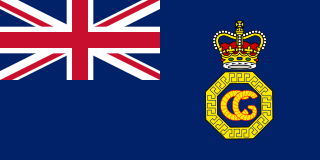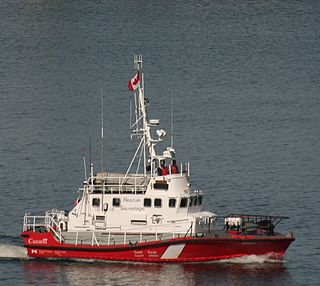
Search and rescue (SAR) is the search for and provision of aid to people who are in distress or imminent danger. The general field of search and rescue includes many specialty sub-fields, typically determined by the type of terrain the search is conducted over. These include mountain rescue; ground search and rescue, including the use of search and rescue dogs ; urban search and rescue in cities; combat search and rescue on the battlefield and air-sea rescue over water.

His Majesty's Coastguard (HMCG) is a section of the Maritime and Coastguard Agency responsible, through the Secretary of State for Transport to Parliament, for the initiation and co-ordination of all maritime search and rescue (SAR) within the UK Maritime Search and Rescue Region. This includes the mobilisation, organisation and tasking of adequate resources to respond to persons either in distress at sea, or to persons at risk of injury or death on the cliffs or shoreline of the United Kingdom. It is also responsible for land based search and rescue helicopter operations from 2015.
The Canadian Coast Guard College (CCGC) is a maritime training college and Canadian Coast Guard facility located in Westmount, Nova Scotia—a suburb of the former city of Sydney in the Cape Breton Regional Municipality.

The Canadian Coast Guard is the coast guard of Canada. Formed in 1962, the coast guard is tasked with marine search and rescue (SAR), communication, navigation, and transportation issues in Canadian waters, such as navigation aids and icebreaking, marine pollution response, and support for other Canadian government initiatives. The coast guard operates 119 vessels of varying sizes and 23 helicopters, along with a variety of smaller craft. The CCG is headquartered in Ottawa, Ontario, and is a special operating agency within Fisheries and Oceans Canada.
Canadian Forces Base Summerside was an air force base located in St. Eleanors, Prince Edward Island, Canada, now part of the city of Summerside.

Canada Command was one of the four operational commands of the Canadian Forces from 2006 to 2012. It was responsible for routine domestic and continental operations, such as search and rescue, sovereignty patrol, national security coordination and contingency planning. As an operational formation, Canada Command used resources generated from the three environmental commands of the Canadian Forces: the Royal Canadian Navy, the Canadian Army and the Royal Canadian Air Force. The command was merged into the Canadian Joint Operations Command in October 2012.

The Canadian Coast Guard Auxiliary is a Canada-wide volunteer marine association dedicated to marine search and rescue (SAR) and the promotion of boating safety, through association with the Canadian Coast Guard under the auspices of Canada's National Search and Rescue Program.

The National Search and Rescue Program (NSP) is the name given by the Government of Canada to the collective search and rescue (SAR) activities in Canada. Until 2015, the NSP was administered by the National Search and Rescue Secretariat (NSS).

413 Transport and Rescue Squadron is an air force squadron of the Canadian Armed Forces. It was originally a flying boat squadron of the Royal Canadian Air Force during the Second World War. It currently operates the C-130 Hercules and the CH-149 Cormorant in transport plus search and rescue roles at CFB Greenwood.
The Joint Rescue Coordination Centre Victoria (JRCC Victoria) is a rescue coordination centre operated by the 1 Canadian Air Division (Canadian Armed Forces) and staffed by personnel of the Royal Canadian Air Force (RCAF) and the Canadian Coast Guard (CCG).

CCGS Sambro is a Canadian Coast Guard motor lifeboat homeported in Sambro, Nova Scotia.
The Joint Rescue Coordination Centre of Northern Norway or JRCC NN is a rescue coordination center located in Bodø which is responsible for coordinating major search and rescue (SAR) operations in Norway north of the 65th parallel north. Its area of operation includes Svalbard, but excludes Jan Mayen. Established in 1970, it is a government agency subordinate to the Ministry of Justice and Public Security and led by the Chief of Police of Salten Police District. The agency has twenty-three employees and has at least two rescue controllers at work at any time.

The Joint Rescue Coordination Centre of Southern Norway or JRCC SN is a rescue coordination center located in Sola which is responsible for coordinating major search and rescue (SAR) operations in Norway south of the 65th parallel north. Established in 1970, it is a government agency subordinate to the Ministry of Justice and Public Security and led by the Chief of Police of Rogaland Police District. The agency has twenty-three employees and has at least two rescue controllers at work at any time.

Canadian Armed Forces Search and Rescue is the collective name used to refer to search and rescue (SAR) resources and operations within the Canadian Armed Forces (CAF). The Royal Canadian Navy (RCN) and Royal Canadian Air Force (RCAF) are jointly responsible for Canada’s SAR operations.
The Joint Rescue Coordination Centre Trenton is a rescue coordination centre operated by the Royal Canadian Air Force (RCAF) and the Canadian Coast Guard (CCG).
A rescue co-ordination centre (RCC) is a primary search and rescue facility in a country that is staffed by supervisory personnel and equipped for co-ordinating and controlling search and rescue operations.
Maritime Rescue Sub-Centre St. John's is one of two Maritime Rescue Sub-Centre's operated by the Canadian Coast Guard.
Maritime Rescue Sub-Centre Quebec is a Canadian Maritime Rescue Sub-Centre that coordinates search and rescue operations in the following waters:
The Cyprus Joint Rescue Coordination Center or JRCC Larnaca is an independent agency of the Ministry of Defence of the Republic of Cyprus and its primary mission is to organize the national Search and Rescue (SAR) system, to co-ordinate, to control and direct SAR operations in the region that the Cyprus JRCC is responsible for, so that people, whose lives are at risk as a result of aviation or maritime accidents, can be located and rescued in the least amount of time.










